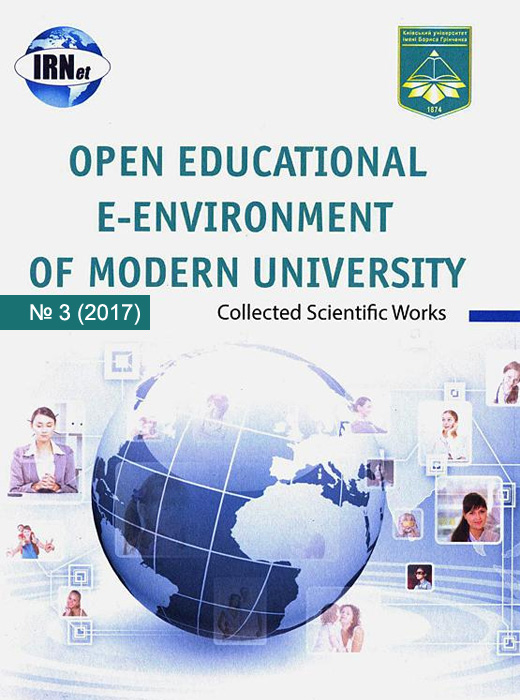ЛЮДИНОЦЕНТРИЧНІ СИСТЕМИ ЯК ІНСТРУМЕНТ НАВЧАЛЬНОЇ ТА ТРУДОВОЇ ДІЯЛЬНОСТІ
DOI:
https://doi.org/10.28925/2414-0325.2017.3.18691Ключові слова:
антропоцентричні системи, освіта, когнітивні вимоги, користувачАнотація
У статті проведено аналіз питань, пов’язаних з рекомендаціями щодо проектування антропоцентричних (людино центричних - в україномовній літературі) систем, їх характеристик та особливостей.
Завантаження
Посилання
Биков, В. Ю. Інноваційний розвиток засобів і технологій систем відкритої освіти. Сучасні інформаційні технології та інноваційні методики у підготовці фахівців: методологія, теорія, досвід, проблеми: зб. наук. праць, випуск 29, Київ-Вінниця: ТОВ фірма «Планер», 2012. 32-40.
Буров, О.Ю. Технології та інновації в діяльності людини ери інформації: людина та ІКТ. Інформаційні технології і засоби навчання. Електронне наукове фахове видання, 2015. № 6 (50). 1-13.
Кузнецов В.О. та ін. Концепція освіти з напряму "Безпека життя і діяльності людини". Інформаційний вісник «Вища освіта». К.: Видавництво Науково-методичного центру вищої освіти МОНУ, 2001. № 6. 6-18.
Пінчук, О.П. та ін. Організація та функціонування мережі ресурсних центрів дистанційної освіти загальноосвітніх навчальних закладів, Київ: Атіка, 2014. 184.
Рябенко, Є.М. Принцип людиноцентризму в управлінні вищою освітою: мотиваційні аспекти професійної діяльності викладача як суб’єкта освітнього процесу. Гуманітарний вісник ЗДІА, 2014. 56. 33-42.
Burov, O. Virtual Life and Activity: New Challenges for Human Factors/Ergonomics. Symposium "Beyond Time and Space" STO-MP-HFM-231, STO NATO, 2014. 8-1…8-8.
Burov, O., Tsarik, O. Educational workload and its psychophysiological impact on student organism. Work. Volume 41, Supplement 1, 2012. 896-899.
Daniel, S. Papp and David, Alberts. Preface: Technology and Change in Human Affairs. The Information Age: An Anthology on Its Impact and Consequences. Edited by David S. Alberts and Daniel S. Papp. CCRP Publication Series. 1997. Pp. ii-viii.
Encyclopedia of the Sciences of Learning. Seel, Norbert M. (Ed.). Springer US, 2012. 3536 p.
Information and Intelligent Systems: Advancing Human-Centered Computing, Information Integration and Informatics, and Robust Intelligence. [Online]. URL: http://www.nsf.gov/pubs/2006/nsf06572/nsf06572.htm#toc.
Kleinberg, Jon. Analysis of large-scale social and information networks. Philosophical Transactions of the Royal Society A, 2013. v.371, Downloaded from http://rsta.royalsocietypublishing.org/ on September 1, 2017.
Lyvynova, S., Burov O. Methods, Forms and Safety of Learning in Corporate Social Networks. ICT in Education, Research and Industrial Applications. Integration, Harmonization and Knowledge Transfer. Proceedings of the 13th International Conference on ICT in Education, Research and Industrial Applications. Integration, Harmonization and Knowledge Transfer, Kyiv, Ukraine, May 15-18, 2017. pp. 406-413. [Online]. URL:: http://ceur-ws.org/Vol-1844/10000406.pdf.
Morze, Nataliia, et al. Ways of formation of effective students' collaboration skills based upon the usage of WBT. International Journal of Web Based Communities, 2015. 11, 25-41, ISSN 1477-8394 (Print) 1741-8216 (Online).
Nakamura, A., Yamaguchi, T., Sato-Shimokawara, E. Intelligent network mobility in human centered city. Soft Computing in Industrial Applications. SMCia '08. IEEE Conference. 25-27 June 2008. 2008. 287 – 292.
Yamaguchi, T.; Sato, E.; Takama, Y. Intelligent space and human centered robotics. Industrial Electronics, IEEE Transactions. 2003. V.50, Is.5. 881 – 889.
REFERENCES (TRANSLATED AND TRANSLITERATED)
Bykov, V. Yu. (2012). Innovative development of tools and technologies of open education systems. Innovatsiinyi rozvytok zasobiv i tekhnolohii system vidkrytoi osvity. Suchasni informatsiini tekhnolohii ta innovatsiini metodyky u pidhotovtsi fakhivtsiv: metodolohiia, teoriia, dosvid, problemy: zb. nauk. prats, vypusk 29, Kyiv-Vinnytsia: TOV firma «Planer», 32-40. (in Ukrainian).
Burov, O. Yu. (2015). Technology and innovation in human activity of the information age: human and ICT. Informatsiini tekhnolohii i zasoby navchannia. Electronic scientific professional edition, № 6 (50), 1-13. (in Ukrainian).
Kuznetsov V.O. etc. (2001). The concept of education in the direction "Safety of life and human activity". Informatsiinyi visnyk «Vyshcha osvita». K.: Vydavnytstvo Naukovo-metodychnoho tsentru vyshchoi osvity MONU, № 6, 6-18. (in Ukrainian).
Pinchuk, O.P. etc. (2014). Organization and functioning of the network of resource centers of distance education of general educational institutions, Kyiv: Atika, 184. (in Ukrainian).
Riabenko, Ye. M. (2014). The principle of human-centeredness in the management of higher education: the motivational aspects of the professional activity of the teacher as a subject of the educational process. Humanitarnyi visnyk ZDIA, 56, 33-42. (in Ukrainian).
Burov, O. (2014). Virtual Life and Activity: New Challenges for Human Factors/Ergonomics. Symposium "Beyond Time and Space" STO-MP-HFM-231, STO NATO, 8-1…8-8.
Burov, O., Tsarik, O. (2012). Educational workload and its psychophysiological impact on student organism. Work. Volume 41, Supplement 1, 896-899.
Daniel, S. Papp and David, Alberts. (1997). Preface: Technology and Change in Human Affairs. The Information Age: An Anthology on Its Impact and Consequences. Edited by David S. Alberts and Daniel S. Papp. CCRP Publication Series. Pp. ii-viii.
Encyclopedia of the Sciences of Learning. (2012). Seel, Norbert M. (Ed.). Springer US, 3536 p.
Information and Intelligent Systems: Advancing Human-Centered Computing, Information Integration and Informatics, and Robust Intelligence. Retrieved from http://www.nsf.gov/pubs/2006/nsf06572/nsf06572.htm#toc. (in Ukrainian).
Kleinberg, Jon. (2013). Analysis of large-scale social and information networks. Philosophical Transactions of the Royal Society A, v.371, Downloaded from http://rsta.royalsocietypublishing.org/ on September 1, 2017.
Lyvynova, S., Burov O. (2017). Methods, Forms and Safety of Learning in Corporate Social Networks. ICT in Education, Research and Industrial Applications. Integration, Harmonization and Knowledge Transfer. Proceedings of the 13th International Conference on ICT in Education, Research and Industrial Applications. Integration, Harmonization and Knowledge Transfer, Kyiv, Ukraine, May 15-18, pp. 406-413. [Online]. Retrieved from http://ceur-ws.org/Vol-1844/10000406.pdf.
Morze, Nataliia, et al. (2015). Ways of formation of effective students' collaboration skills based upon the usage of WBT. International Journal of Web Based Communities, 11, 25-41, ISSN 1477-8394 (Print) 1741-8216 (Online).
Nakamura, A., Yamaguchi, T., Sato-Shimokawara, E. (2008). Intelligent network mobility in human centered city. Soft Computing in Industrial Applications. SMCia '08. IEEE Conference. 25-27 June 2008. 287 – 292.
Yamaguchi, T.; Sato, E.; Takama, Y. (2003). Intelligent space and human centered robotics. Industrial Electronics, IEEE Transactions. V.50, Is.5. 881 – 889.













1.jpg)








